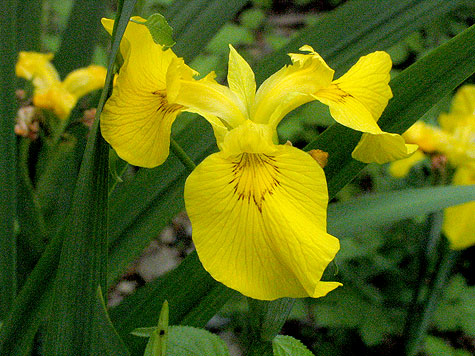
WARNING: Yellow flag could spread and dominate a wetland site if allowed. It has become established in natural areas in North America, but apparently has not become a problem severe enough to be placed on restricted plant lists - yet. Do not plant yellow iris in natural bodies of water or anywhere it might escape into the wild.
Yellow flag is a robust and vigorous iris with ribbed grayish green sword shaped leaves 3-5 ft (0.9-1.5 m) long and profuse yellow flowers 3-4 in (1.2-1.6 cm) across borne on erect stems to 4 ft (1.2 m) tall. As in all irises, the flowers of yellow flag are composed of six perianth segments: three outer ones called "falls" which droop outward and down, and, alternating with the falls, three inner segments called "standards." The falls and standards of yellow flag are bright yellow with violet or brownish veins. In addition, each fall has a darker yellow-brown blotch near its base. There are usually 4-12 flowers on each branched flower stalk, and they appear in early spring. The selection, 'Alba' has cream colored flowers; 'Gigantea' has stems to 8 ft (2.4 m) tall and large golden yellow flowers; 'Variegata' has young springtime leaves striped with yellow; 'Golden Fleece' has falls and standards lacking the darker markings; 'Flore-Pleno' has double flowers. The botanical variety bastardii has very pale yellow flowers without markings.
 Yellow Iris
Yellow Iris